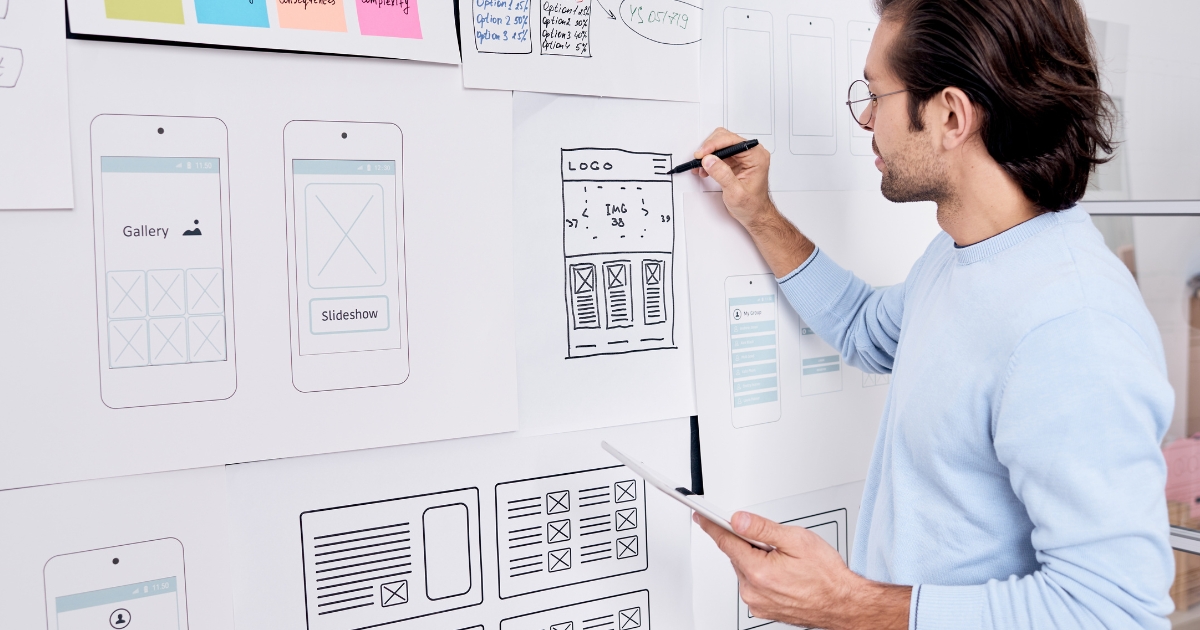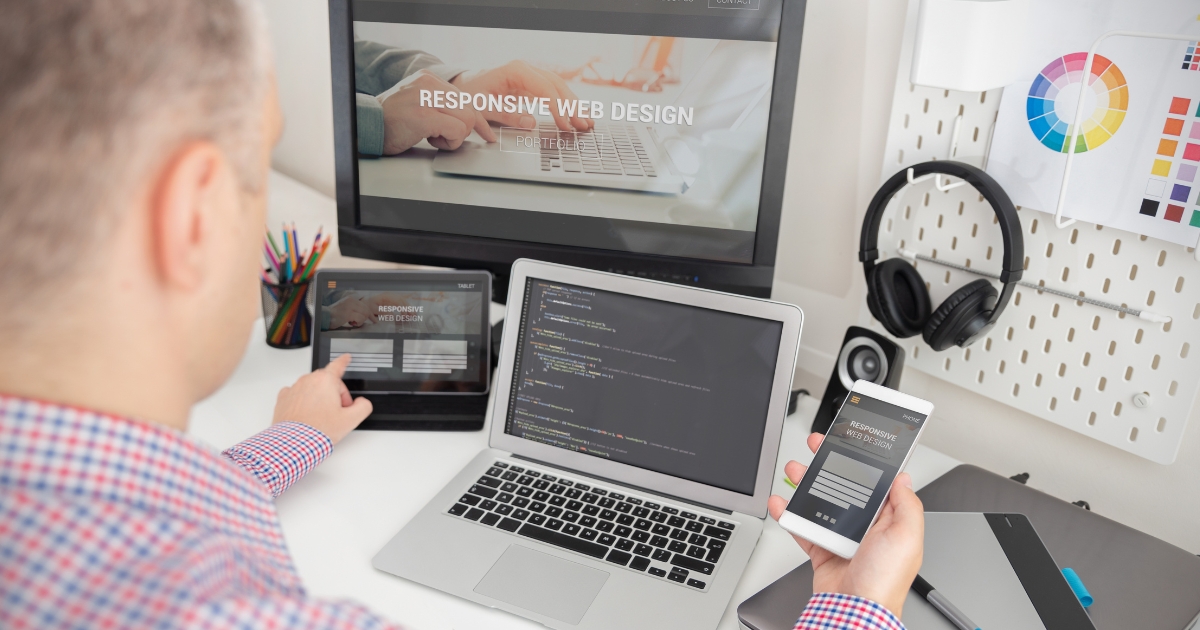Web design encompasses a wide range of elements that are essential for creating an effective and user-friendly website. It involves the process of planning, designing, and developing a website, with an aim to make it visually appealing, easy to navigate, and useful to the target audience.
In today’s digital age, most people use smartphones and other mobile devices to access the internet. Therefore, it is crucial for businesses to have an online presence. Effective web design is critical for the success of any business, regardless of its size or industry. A well-designed website not only helps businesses to reach a wider audience but also establishes trust and credibility.
The purpose of this guide is to provide a comprehensive overview of the essential elements of effective web design. The guide covers various aspects of web design, including usability and accessibility, visual design, content, search engine optimisation, interactivity, and testing and maintenance. By understanding and implementing these elements, businesses can create a user-friendly, visually appealing, and easily discoverable website by search engines.
This guide is for anyone looking to create or improve their website. Whether you are a small business owner, a web designer, or a marketer, this guide will provide you with the knowledge and tools you need to create an effective and successful website.

Usability and accessibility
Usability and accessibility are essential components of web design. Navigation, mobile-friendliness, and accessibility for visually impaired users are all important factors that contribute to the overall user experience. A website that is easy to navigate and use will keep visitors on the site for longer, leading to more conversions and better engagement.
Navigation
One of the most important aspects of web design is navigation. Navigation refers to the process of moving through a website and accessing different pages and content. Navigation can be achieved through a menu structure or search functionality, and it should be intuitive and easy to use.
Menu structure
The menu structure is the primary means of navigation on a website. It is typically located at the top of the website and allows users to access different pages and sections. The menu structure should be organised in a logical and intuitive manner, with clear and descriptive labels for each menu item.
Search functionality
Another important aspect of navigation is the search functionality. A search bar allows users to quickly find specific content within a website, making it more user-friendly. It is important to ensure that the search function is easily accessible and that the results are relevant and accurate.
Mobile friendliness
With the increasing use of mobile devices, websites must be mobile-friendly. Mobile friendliness refers to the ability of a website to adapt to different screen sizes and resolutions and to provide an optimal viewing experience on mobile devices. This includes easy-to-use navigation, larger text, and larger buttons.
Accessibility for visually impaired users
Accessibility is an important aspect of web design. It refers to the ability of a website to be used by people with disabilities, such as visually impaired users. This includes features such as alternative text for images, high-contrast colour schemes, and keyboard navigation.
Usability and accessibility are critical elements of effective web design. Navigation, mobile-friendliness, and accessibility are all important aspects of usability and accessibility. A website should be easy to navigate, with a logical menu structure and search functionality. It should also be mobile-friendly and accessible to visually impaired users. By focusing on usability and accessibility, businesses can create a website that is easy to use and caters to all users’ needs.

Visual design
Visual design is the way that a website looks and feels. A website’s colour scheme, typography, images, graphics, layout, and white space all play a crucial role in the overall visual design. These elements can create a cohesive, visually pleasing design that will attract and retain visitors.
The colour scheme of a website is one of the most important elements of visual design. The colours used on a website should be in line with the brand and create a visually pleasing and cohesive look. The colour scheme should be consistent throughout the website and easy on the eyes.
Typography refers to the style and arrangement of text on a website. The choice of font and font size is an important aspect of typography. The font should be easy to read and consistent throughout the website. The font size should be large enough to be easily readable and consistent across different devices and screen sizes.
Images and graphics are important elements of visual design. They can enhance a website’s overall look and feel and communicate information and ideas. However, it is important to use images and graphics that are relevant, high-quality, and do not slow down the website.
Layout and white space
Layout refers to the arrangement of elements on a website. The layout should be visually pleasing and should be easy to navigate. White space, or negative space, refers to the empty areas on a website. It is an important aspect of layout as it can help create a sense of balance and make a website look less cluttered.
Visual design is an essential element of web design. It can greatly influence how users perceive and interact with a website. The colour scheme, typography, images, graphics, layout, and white space all contribute to the overall visual design of a website and should be used to create a cohesive and visually appealing look. By paying attention to visual design, businesses can create a website that is not only easy to use but also beautiful and visually appealing.

Content
Content is the heart of any website. Writing for the web, content organisation, and multimedia are all important considerations when creating a website. Effective content will help to keep visitors engaged, increase conversions, and improve search engine rankings.
A website’s content is one of the most important elements of web design. Writing for the web is different from writing for print, as web users tend to scan content rather than read it fully. Therefore, it is important to use headings, bullet points, and short paragraphs to break up the text and to make it easy to scan.
Content organisation is the process of structuring and arranging content on a website. A well-organized website should have a clear and logical hierarchy, with the most important information at the top of the page. The content should be grouped into categories and subcategories with easy-to-use headings and labels.
Multimedia, such as images, videos, and audio files, can be used to enhance a website’s content and make it more engaging. However, it is important to use relevant, high-quality multimedia that does not slow down the website.
Content is one of the most important elements of web design. A website should have high-quality, well-written, and well-organized content that is easy to scan. Writing for the web should be different from writing for print, using headings, bullet points, and short paragraphs to break up the text. A well-organized website should have a clear and logical hierarchy, with the most important information at the top of the page.

Search engine optimisation (SEO)
Search engine optimisation (SEO) is the process of improving a website’s visibility in search engine results. This can be achieved using keywords, meta tags, sitemaps, and URL structure. A well-optimised website will rank higher in search engine results, leading to more traffic and better visibility.
Keywords are the words and phrases people use to search for information on the internet. They are an important aspect of SEO as they help search engines understand what a website is about. It is important to use relevant keywords throughout the website, including title tags, meta descriptions, and content.
Meta tags provide information about a website to search engines. These tags should be well-written and relevant and include the relevant keywords. They include the title tag in the browser tab and the meta description in the search results.
A sitemap is a file that lists all the pages on a website and how they are related to one another. It helps search engines understand the structure of a website and can improve the visibility of a website in search results.
The URL structure of a website is how the pages of a website are organised and linked together. URLs should be easy to read, relevant and consistent throughout the website. They should also include relevant keywords where possible.
Search engine optimisation (SEO) is an essential element of web design. It helps to improve the visibility of a website in search results. Businesses can improve their website’s visibility in search engines by using relevant keywords, meta tags, sitemaps and having a well-structured URL. This can lead to more visibility, more traffic, and more business. As SEO is an ongoing process, it is important to regularly monitor and update the website to ensure it is up to date with the latest SEO best practices.

Interactivity
Interactivity is an important aspect of web design. Forms, feedback mechanisms, and social media integration contribute to the overall user experience. These elements can be used to create a more engaging and interactive website that will keep visitors on the site for longer.
Forms are an important aspect of interactivity as they allow users to submit information to the website. Forms can be used for various purposes, such as contact forms, registration forms, and surveys. They should be easy to use, with clear and concise instructions, and provide clear feedback to the user.
Feedback mechanisms like comments and ratings allow users to interact with a website and provide feedback. Feedback mechanisms should be easy to use and provide clear feedback to the user. They can be a valuable tool for businesses to understand their customers and improve their products and services.
Social media integration refers to connecting a website to social media platforms like Facebook, Twitter, and Instagram. This allows users to share content from the website on their social media profiles, which can help to increase visibility and attract new visitors.
Interactivity is an essential element of web design. It allows users to interact with a website and provide feedback. Forms, feedback mechanisms, and social media integration are all important aspects of interactivity. Forms allow users to submit information to the website, feedback mechanisms allow users to provide feedback, and social media integration allows users to share content from the website on their social media profiles. By focusing on interactivity, businesses can create a website that is not only easy to use but also interactive and engaging.

Testing and maintenance
Testing and maintenance are crucial for ensuring that a website functions correctly. User testing, browser compatibility, and regular updates and backups are all important considerations when creating and maintaining a website.
User testing is the process of testing a website with real users to identify any usability issues. It can be done through surveys, interviews, or usability testing sessions. User testing is an important step in the web design process as it allows businesses to identify any issues and make necessary improvements before the website is launched.
Browser compatibility refers to the ability of a website to be accessed and viewed correctly on different web browsers. It is important to ensure that a website is compatible with the most popular web browsers, such as Google Chrome, Mozilla Firefox, and Microsoft Edge, to ensure that all users can access the website.
Regular updates and backups are essential for maintaining a website. Updates can include security patches, bug fixes, and new features, while backups ensure that a website can be restored in case of a problem. Regularly updating and backing up a website ensures that it remains secure and functional.
Testing and maintenance are essential elements of web design. User testing allows businesses to identify and fix usability issues before launching the website. Browser compatibility ensures that the website can be accessed and viewed correctly on different browsers. Regular updates and backups help ensure a website remains secure and functional. By focusing on testing and maintenance, businesses can create a website that is easy to use, secure, and reliable.
Effective web design is a combination of usability, accessibility, visual design, content, search engine optimisation, interactivity, and testing and maintenance. A well designed website should be easy to navigate, visually pleasing, and optimised for search engines. It should also be engaging and interactive and regularly tested and maintained.
The future of web design looks to be increasingly focused on mobile first design, accessibility, and user experience. As more and more people access the internet through their mobile devices, websites must be optimised for smaller screens and touch-based navigation.
Additionally, accessibility is becoming increasingly important as more and more people with disabilities access the internet. It’s also important that web designers consider user experience when creating a website. This will help to create an engaging and intuitive experience that will keep visitors on the site for longer.
If you’re interested in learning more about web design, many resources are available to help you. Online tutorials, web development courses, and books on web design are all excellent ways to gain the knowledge and skills you need to create effective websites.
Remember to stay up to date with web design trends and best practices. By staying informed about the latest developments in web design, you’ll be better equipped to create effective and engaging websites.

Frequently asked questions
How can I improve my web design skills?
To improve your web design skills, you can take online tutorials and web development courses and read books on web design. Additionally, staying informed about the latest trends and best web design practices can help improve your skills.
What is the importance of interactivity in web design?
Interactivity is an important aspect of web design as it helps to create a more engaging and interactive website that will keep visitors on the site for longer. Elements such as forms, feedback mechanisms, and social media integration can contribute to the overall user experience.
What are some best practices for testing and maintenance in web design?
Best practices for testing and maintenance in web design include user testing, browser compatibility testing, and regularly updating and backing up the website. This ensures that the website is functioning correctly and that any issues are identified and addressed in a timely manner.
How can I ensure that my website is accessible to visually impaired users?
To ensure a website is accessible for visually impaired users, designers can use techniques such as high-contrast colour schemes, larger font sizes, and alternative text for images. Additionally, following accessibility guidelines such as the Web Content Accessibility Guidelines (WCAG) can help improve accessibility.
How important is mobile friendliness in web design?
Mobile friendliness is becoming increasingly important as more and more people access the internet through their mobile devices. Websites must be optimised for smaller screens and touch based navigation to ensure they are accessible and easy to use on mobile devices.
What are some resources for further learning in web design?
There are many resources available for further learning in web design, including online tutorials, web development courses, and books on web design. Additionally, staying informed about the latest trends and best practices in web design through industry blogs and forums can also be helpful.







